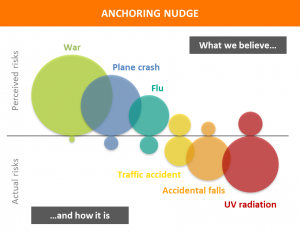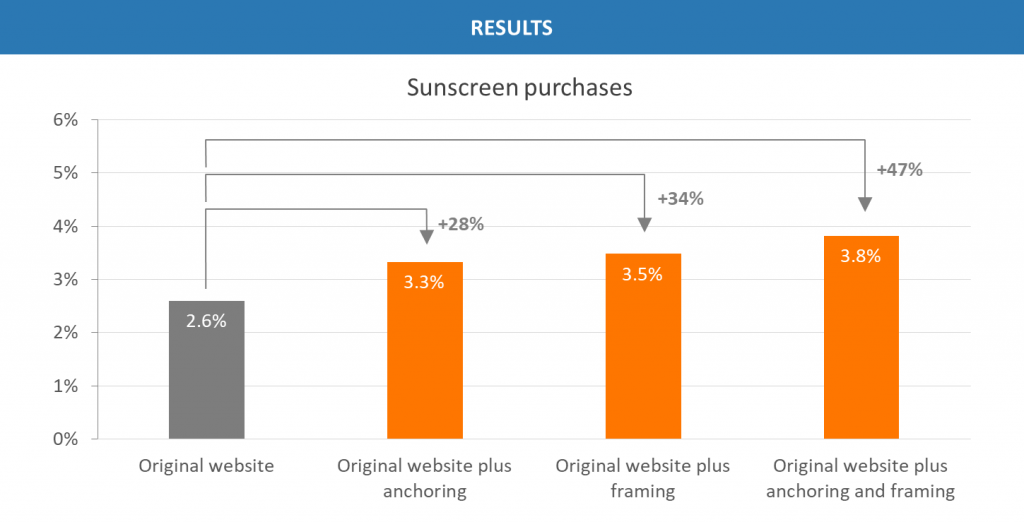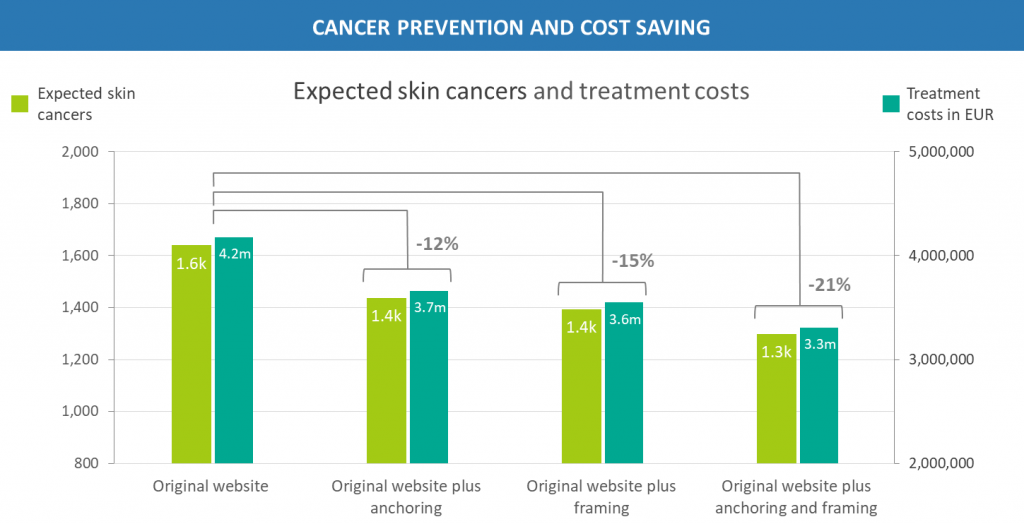Behavioral risk communication
This case study addresses how behavioral insights can support risk management and effectively mobilize preventive action. It builds on a real-world challenge, while the solution and the underlying data are illustrative examples only. [1]
Behavioral root causes: What drives feelings of risk and safety?
Whether insurance uptake, business investments, workplace tasks or everyday behaviors – people are constantly confronted with risky environments in which they have to make decisions. The bad news is that people have difficulties in understanding and coping with risks: they often neglect very likely and dangerous risks, e.g., workplace accidents or cancer, but utterly fear rarely occurring but vivid risks, e.g., airplane crashes or war.[2]
Understanding how these misperceptions arise and what can be done in order to improve risk taking behavior is important for governments, authorities and many companies. Should they invest into means of communication or means of precaution to manage people’s feelings of risk and safety?
The good news is that risk attitudes and fears are predictable. Behavioral insights can help to rectify misperceptions and improve people’s decision-making under risk.
Behavioral design: How to mobilize precaution?
In this case study, we give a brief introduction into behavioral risk management. The case relates to an everyday example of risk taking: people’s excessive exposure to UV radiation.
UV radiation can damage the DNA in skin cells and is the major cause of skin cancer. Even though most people know that unprotected sun exposure increases the chances of skin cancer, a vast majority underestimates or completely neglects the risk in daily decision-making.
An agency responsible for disease prevention and risk communication seeks to improve citizens’ behaviors in coping with UV radiation. The specific task is to mobilize sunscreen uptake by help of online communication. Here are two possible nudge solutions demonstrating how behavioral insights can support the agency’s efforts to effectively communicate risks.
1. Option: Anchoring nudge
Most visitors go to the agency’s website to get latest updates on rampant diseases. Their queries depend on the season: in winter, for example, visitors look for tips on flu prevention. This tells us two things: first, visitors are already in a state of alert when reaching the website and, second, their alertness currently focusses on the flu. We can utilize this information to draw visitors’ attention to the more dangerous risk of UV radiation.
A very powerful approach to moderate fear is the use of anchors. Visitors can be presented with intuitive illustrations about the gap between actual and perceived threats. The illustration in our example ranks six risks according to their lethality, among them flu – the anchor – and UV radiation. Such illustrations explicitly show visitors what they “should” be worried about: their concerns are put into perspective so that they are directed from their anchor to the most dangerous, yet underestimated risks.
2. Option: Framing nudge
Another way to encourage sun protection is framing. Framing influences a person’s perceptions and judgments on a subconscious level. The original webpage content is enhanced to highlight the negative consequences which arise from excessive exposure to UV radiation. It also includes a concerned tonality and respective action prompts. The underlying key message is “if you fail to take precautionary action, you put yourself and your beloved ones at risk”.
Although targeting a visitor’s conscience in a subtle way, framing nudges do not alter the actual content of the original webpage. Visitors are still provided with accurate information. But the information is presented in a way that increases alertness to UV radiation which narrows the gap between actual and perceived risk.
Behavioral pilot: What works best to increase sunscreen uptake?
To learn which nudge has the highest impact on sunscreen uptake, let us assume that the agency wants to test four versions of its website: the first version is the original website without any nudge. The second version is the original website plus the anchoring nudge, the third version is the original website plus the framing nudge, and the fourth version is the original website plus both nudges, anchoring and framing.
A short pop-up before exiting the website could ask all visitors if they would like to buy sunscreen from a certified, non-profit platform offering free shipping and next day delivery. If they agree, they are directed to the platform and their purchase decisions are tracked. Following a two-week trial period, sunscreen purchases for the four versions would be compared. They serve as an indicator for sunscreen uptake.
Evaluation: What does it mean for prevention and costs?
The exemplary data suggests that anchoring and framing nudges would substantially improve precautionary action among website visitors. Anchoring would increase purchases by 28% and framing by 34%. If the website displays both nudges, purchases would go up by 47%.
What would this mean for actual prevention? The website is visited by around 500,000 people every year. Assuming that 60% of the visitors use sunscreen, we can calculate the number of prevented skin cancers as well as savings for medical treatment.[3]
If the original website continues to operate without any nudge, 1.640 of the 500,000 visitors are expected to suffer from skin cancer next year. Costs for medical treatment would amount to EUR 4.17m. If anchoring is added, only 1,436 visitors would suffer from skin cancer and the costs for medical treatment would drop to EUR 3.66 m, a reduction of around 12%. If the original website includes the framing nudge, only 1,393 visitors are expected to suffer from skin cancer next year and the total costs for treatment would amount to EUR 3.55m, i.e. 15% less than under the original website. The most effective combination in this example would be to use both anchoring and framing nudges, reducing the number of skin cancers and costs for medical treatment by 21% (1,298 infected visitors at costs of EUR 3.31).
Key takeaway
Whether vaccination, workplace safety, or cancer prevention – providing accurate information is sometimes not enough. When people make fundamental errors in judging risky situations, behavioral insights can help to rectify these mistakes and promote better decision-making. Behavioral risk management mobilizes preventive action and thereby contributes to improving well-being and saving substantial costs.
If you are interested in behavioral approaches for public risk management, please get in touch with us. We are always excited to learn more and help if we can.
[1] Behavia makes no warranty, representation or undertaking whether expressed or implied, nor does it assume any legal liability, whether direct or indirect, or responsibility for the accuracy, completeness, or usefulness of any information presented in the case study.
[2] See, for example, Schubert, M., and Brueck, T. (2014), “The Perception of Lethal Risks: Evidence from a Laboratory Experiment”, https://www.iza.org/publications/dp/8578/the-perception-of-lethal-risks-evidence-from-a-laboratory-experiment (last accessed on 10/12/2019)
[3] Prevention and savings data are taken from King, D., Greaves, F., Vlaev, I., and Darzi, A. (2013) , “Approaches Based On Behavioral Economics Could Help Nudge Patients And Providers Toward Lower Health Spending Growth”. Health Affairs 32(4): 661-668, and Robert Koch-Institut und die Gesellschaft der epidemiologischen Krebsregister in Deutschland e.V. (2015), “Krebs in Deutschland 2011/2012“, 10. Ausgabe, Berlin. We assume an online vs. offline purchase rate of 9.1.



